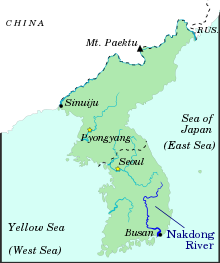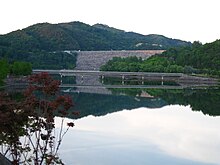geo.wikisort.org - River
The Nakdonggang River or Nakdonggang (Korean pronunciation: [nakt͈oŋgaŋ])[lower-alpha 4] is the longest river in South Korea, and passes through major cities such as Daegu and Busan. It takes its name from its role as the eastern border of the Gaya confederacy during Korea's Three Kingdoms Era.
| Nakdonggang River | |
|---|---|
 The Nakdonggang in Andong, North Gyeongsang | |
 The Nakdonggang River | |
| Native name | 낙동강 (Korean) |
| Location | |
| Country | South Korea |
| Provinces | Gangwon, North Gyeongsang, Daegu, South Gyeongsang, Busan |
| Physical characteristics | |
| Source | Taebaek Mountains |
| • location | Eundae Peak, Taebaek, Gangwon[lower-alpha 1][1] |
| Mouth | Sea of Japan |
• location | Estuary Bank, Gangseo, Busan |
| Length | 510 km (320 mi)[2] |
| Basin size | 23,384 km2 (9,029 sq mi)[2] |
| Discharge | |
| • location | Jindong, Haman[lower-alpha 2][3] |
| • average | 383 m3/s (13,500 cu ft/s)[lower-alpha 3][3] |
| Basin features | |
| Tributaries | |
| • left | Banbyeoncheon, Geumhogang River, Miryanggang River, Yangsancheon, West Nakdonggang River † |
| • right | Naeseongcheon, Gamcheon, Hwanggang River, Nam River |
| † : Distributary of Nakdonggang | |
| Nakdong River | |
| Hangul | |
|---|---|
| Hanja | |
| Revised Romanization | Nakdonggang |
| McCune–Reischauer | Naktonggang |

Geography
The Nakdonggang flows from the Taebaek Mountains to the South Sea or Korean Strait, which separates Korea from Japan. The river originates from the junction of the Cheolamcheon and Hwangjicheon streams in Dongjeom-dong, Taebaek city, Gangwon province. From there to its mouth it winds for about 506 kilometres (314 mi). The width of the river ranges from only a few metres in its upper reaches, to several hundred metres towards its estuary.
Major tributaries include the Yeong, Geumho, and Nam rivers. Together with its tributaries, the Nakdonggang drains most of North Gyeongsang and South Gyeongsang provinces, along with small portions of North Jeolla, South Jeolla, and Gangwon. The total watershed is 23,384 square kilometres (9,029 sq mi).
History

The Nakdonggang River has played an important role throughout Korean history. The river basin has been a favored dwelling-place for as long as people have inhabited the Korean peninsula. Numerous Neolithic remains have been found in the valley.
Around the 1st century, the valley is believed to have been inhabited by the Byeonhan confederacy tribes. During the Three Kingdoms period, the Gaya confederacy controlled the valley, until they were overrun by Silla in 562. These states exploited the river's potential for navigation and commerce, operating a thriving trade in armor and weapons with neighboring countries, including Yamato period Japan. Through the Silla, Goryeo, and Joseon periods, the river continued to serve as a major transportation corridor in the Gyeongsang region. It was especially used for transporting fresh seafood inland, such as mackerel, which were salted and dried in order to prevent them from spoiling. The city of Andong was the farthest inland the fish could be brought before going bad, so many people flocked there during the Joseon Dynasty to eat fish.[5]
As a barrier to movement, the Nakdonggang River gained sudden prominence during the Korean War. The southern length of the river formed the western portion of the Pusan Perimeter, which the UN forces fought to maintain during the autumn of 1950. The bridge over the Nakdonggang River at Waegwan was blown up on August 3, 1950 in an effort to prevent North Korean forces from advancing on Daegu. A large number of South Korean refugees were killed in the explosion.[6] Although some North Korean forces did cross the Nakdonggang River in places, for the most part the river still marks their furthest advance.
Nakdonggang river phenol contamination incident
In 1991, there were two incidents where phenol was leaked into the river from Doosan Electronics. There were two leaks, the first thirty tons on March 14, 1991 and the second 1.3 tons on April 22. The phenol ended up at a water processing facility used for drinking water in Daegu and began to smell after becoming chlorophenol when the water was sanitized with chlorine.
Ecology
The Nakdonggang valley includes numerous floodplain wetlands, the most well-known of which are the Joonam Reservoirs near Changwon City and Upo Ramsar site, in Changnyeong County, South Gyeongsang. These wetlands, while significantly degraded and overdeveloped, still provide habitat to a significant number of rare and threatened species, most especially birds (such as the Baikal Teal, Anas formosa, and White-naped Crane, Grus vipio), fish and plants. Despite being home to the bustling Port of Busan, the Nakdonggang Estuary is also internationally important for waterbirds, despite recent ecologically-destructive developments including reclamation for housing and industry (e.g. the Busan New Port), the ongoing construction of a major bridge (the Miyeonji Bridge) and most recently the threatened construction of the Korean Grand Canal project.
The Nakdonggang and its tributaries also serve as a major source of drinking water for the inhabitants of the river basin and others nearby. However, water pollution due to domestic and agricultural wastewater remains a serious concern.
Economic role

Although all but the southernmost reaches of the Nakdonggang River have ceased to serve as a major commercial waterway, the river continues to feed those dwelling near it, both directly through fishing and indirectly through irrigation. Substantial amounts of snails and catfish are taken from the waters and used in local cuisine.
Near Andong, a series of massive hydroelectric dams have been constructed, creating a small chain of artificial lakes of which Andong Lake is the largest. These lakes also support a substantial recreational industry. Bass fishing is especially popular, since the lakes have been artificially stocked with bass.
In the early 2010s, the Nakdonggang River was to be part of former Korean president Lee Myung Bak's canal project, the Grand Korean Waterway. The project would link the Nakdong with the Han River to the north, creating a shipping canal spanning length of the country, from Seoul to Busan. Encountering considerable controversy nationwide as well as from residents along the Nakdonggang, the Waterway project was scrapped by the end of Lee's presidency.
Festival
Nakdonggang River Bicycle Festival - The Nakdong River Cultural Center hold bicycle festivals that everyone can enjoy the healthy leisure culture of local residents. It is composed of flat courses about 20Km in the vicinity of Eulsukdo and Nakdonggang River Cultural Center.[7]
See also
- Geography of South Korea
- List of rivers of Asia
- West Nakdong River
Notes
- Eundae Peak (1,442.3m, Korean: 은대봉; Hanja: 銀臺峰; RR: Eundaebong. The peak is also known as the Sanghambaek Mountain (상함백산) or Cheonui Peak (천의봉).)
- Discharge average from 2004 to 2013.
- Discharge average from 2004 to 2013.
- In the 19th century, it was also known in English sources as Nam-tong River or Nam-tong Kang.[4] The name was romanized as Naktong during the Korean War.
References
- 2013년 한국하천일람 [List of Rivers of South Korea, 2013] (PDF) (in Korean). Han River Flood Control Office, Republic of Korea. 31 December 2012. pp. 22, 25, 29, 136–137. Archived from the original (PDF) on 4 March 2016. Retrieved 7 July 2014.
- HRFCO 2012 Archived 2016-03-04 at the Wayback Machine, pp. 22, 25, 33, 136-137.
- 2014년 1월 월간 수자원 현황 및 전망 [Monthly Status & Predictions Report on Water Resources, January 2014] (in Korean). Han River Flood Control Office, Republic of Korea. 13 January 2014. p. 3. Archived from the original (HWP) on 15 July 2014. Retrieved 17 July 2014.
- EB (1878), p. 390.
- "Archived copy". Archived from the original on 2012-04-02. Retrieved 2011-11-09.
{{cite web}}: CS1 maint: archived copy as title (link) - "1950" Retrieved October 10, 2019
- "낙동강자전거페스티벌 2018". korean.visitkorea.or.kr (in Korean). Retrieved 2018-06-12.
Bibliography
- , 'Encyclopædia Britannica, 9th ed., Vol. VI, New York: Charles Scribner's Sons, 1878, pp. 390–394.
На других языках
[de] Nakdonggang
Der Nakdonggang, auch Nakdong-Fluss genannt, ist mit 526 km der längste Fluss Südkoreas.- [en] Nakdong River
[es] Río Nakdong
El río Nakdong (en hangul:낙동강, en hanja:洛東江) es el río más largo de Corea del Sur. Atraviesa ciudades importantes como Daegu y Busán.[it] Nakdong
Il fiume Nakdong (낙동강?, 洛東江?, NakdonggangLR) è il principale fiume della Corea del Sud e tra le grandi città che tocca ci sono Taegu e Pusan.[ru] Нактонган
Нактонга́н[1][2][3] (кор. 낙동강) — самая длинная река в Республике Корея, вблизи которой расположены несколько крупнейших городов страны, таких как Тэгу и Пусан (вблизи устья). Впадает в бухту Нактонпхо[3] в Западном проходе Корейского пролива[1].Другой контент может иметь иную лицензию. Перед использованием материалов сайта WikiSort.org внимательно изучите правила лицензирования конкретных элементов наполнения сайта.
WikiSort.org - проект по пересортировке и дополнению контента Википедии